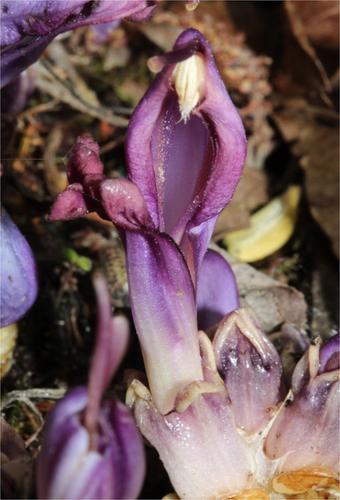Our official English website, www.x-mol.net, welcomes your feedback! (Note: you will need to create a separate account there.)
Biological Flora of the British Isles: Lathraea clandestina
Journal of Ecology ( IF 5.5 ) Pub Date : 2020-08-14 , DOI: 10.1111/1365-2745.13473 Mark D. Atkinson 1 , Elaine Atkinson 2
中文翻译:

英伦三岛的生物区系:Lathraea clandestina
更新日期:2020-08-14
Journal of Ecology ( IF 5.5 ) Pub Date : 2020-08-14 , DOI: 10.1111/1365-2745.13473 Mark D. Atkinson 1 , Elaine Atkinson 2
Affiliation

|
- This account presents information on all aspects of the biology of Lathraea clandestina L. (Purple Toothwort) that are relevant to understanding its ecological characteristics and behaviour. The main topics are presented within the standard framework of the Biological Flora of the British Isles: distribution, habitat, communities, responses to biotic factors, responses to environment, structure and physiology, phenology, floral and seed characters, hervbivores and disease, history and conservation.
- Lathraea clandestina is a holoparasitic perennial herb essentially devoid of chlorophyll which can parasitize a wide range of host plants. These include ferns, herbs and trees although it is most frequent on Populus spp., Salix spp. and Alnus glutinosa. It usually flowers between April and June. It is pollinated principally by long‐tongued bumblebees (Bombus spp.). The flowers arise directly from a subterranean stem and have specialised features to reduce nectar theft particularly by ants and birds. Seeds are explosively ejected and can spread up to 8 m. For most of the year, plants are not visible.
- Lathraea clandestina is native to Belgium, throughout much of western France as far north as Brittany, Andorra, the Pyrenees in France and Spain, northern Spain and in Italy where it has a very disjunct distribution. It has been widely introduced in Britain and Ireland and is extensively naturalised. It has been introduced and naturalised also in The Netherlands, Switzerland and Germany. It is very commonly a riparian plant and can spread downstream.
- As a parasite dwelling underground for most of the year, L. clandestina draws solutes from the xylem of the host root using hydathode glands on the inner surface of the scales. Consequently a stream of liquid is exuded which affects surrounding vegetation. Lathraea clandestina still exhibits vestiges of some of the enzyme activity associated with photosynthesis and has a very limited ability to assimilate inorganic nitrogen and carbon. Its chloroplast genome is less reduced than in many other holoparasitic plants.
中文翻译:

英伦三岛的生物区系:Lathraea clandestina
- 该帐户介绍了有关Lathraea clandestina L.(紫色牙膏)生物学各个方面的信息,这些方面与了解其生态特征和行为有关。主要主题在不列颠群岛生物区系的标准框架内介绍:分布,栖息地,群落,对生物因子的响应,对环境,结构和生理学的响应,物候,花和种子特性,Hervbivores和疾病,历史和保护。
- Lathraea clandestina是一种多年生全寄生的草本植物,基本不含叶绿素,可将多种寄主植物寄生。这些包括蕨类,草药和树木,尽管在胡杨属,柳属属中最常见。和nu木。通常在四月到六月之间开花。主要由长嘴大黄蜂(Bombus spp。)授粉。花直接来自地下茎,具有特殊的功能以减少花蜜被蚂蚁和鸟类盗窃。种子爆炸性地喷出,可传播至8 m。在一年中的大部分时间里,看不见植物。
- Lathraea clandestina原产于比利时,遍及法国西部大部分地区,北至布列塔尼,安道尔,法国和西班牙的比利牛斯山脉,西班牙北部和意大利,分布非常分散。它已在英国和爱尔兰广泛引入,并被广泛归化。它已在荷兰,瑞士和德国引入并归化。它是非常常见的河岸植物,可以向下游扩散。
- 作为一种寄生虫居住的地下最多的一年,L. clandestina使用尺度的内表面上hydathode腺体主机根木质部吸引溶质。因此,渗出的液体流会影响周围的植被。Lathraea clandestina仍然表现出一些与光合作用相关的酶活性的痕迹,并且吸收无机氮和碳的能力非常有限。与许多其他全寄生植物相比,其叶绿体基因组的减少程度较小。



























 京公网安备 11010802027423号
京公网安备 11010802027423号